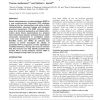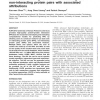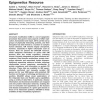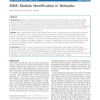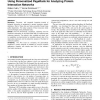287
Voted
RECOMB
2012
Springer
13 years 3 months ago
2012
Springer
Abstract. Since the first emergence of protein-protein interaction networks, more than a decade ago, they have been viewed as static scaffolds of the signaling-regulatory events ...
134
Voted
KDD
2012
ACM
13 years 3 months ago
2012
ACM
We study a novel clustering problem in which the pairwise relations between objects are categorical. This problem can be viewed as clustering the vertices of a graph whose edges a...
238
click to vote
IHI
2012
13 years 8 months ago
2012
Despite recent progress in high-throughput experimental studies, systems level visualization and analysis of large protein interaction networks (ppi) remains a challenging task, g...
148
click to vote
SDM
2011
SIAM
14 years 3 months ago
2011
SIAM
We present a model that improves entity entity link modeling in a mixed membership stochastic block model, by jointly modeling links with text about the entities that are linked i...
108
Voted
NAR
2011
14 years 3 months ago
2011
Binary subcomplexes in proteins database (BISC) is a new protein–protein interaction (PPI) database linking up the two communities most active in their characterization: structu...
126
Voted
NAR
2011
14 years 3 months ago
2011
KUPS (The University of Kansas Proteomics Service) provides high-quality protein–protein interaction (PPI) data for researchers developing and evaluating computational models fo...
137
click to vote
NAR
2011
14 years 3 months ago
2011
An essential prerequisite for any systems-level understanding of cellular functions is to correctly uncover and annotate all functional interactions among proteins in the cell. To...
131
click to vote
NAR
2011
14 years 3 months ago
2011
Chromatin modification (CM) is a set of epigenetic processes that govern many aspects of DNA replication, transcription and repair. CM is carried out by groups of physically inter...
132
Voted
BMCBI
2011
14 years 4 months ago
2011
Background: Graphical models of network associations are useful for both visualizing and integrating multiple types of association data. Identifying modules, or groups of function...
133
click to vote
BIOINFORMATICS
2011
14 years 4 months ago
2011
Motivation: Enormous, and constantly increasing quantity of biological information is represented in protein interaction network databases. Most of these data are freely accessibl...


